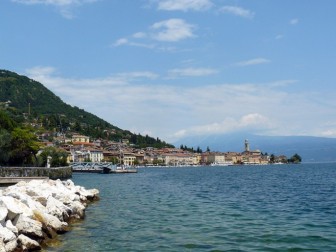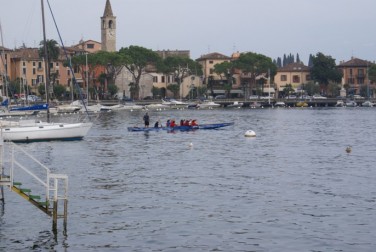Salò
 Salò is an elegant and popular holiday resort sitting in a marvellous position on the bay of the same name where it is protected from northerly winds.
Salò is an elegant and popular holiday resort sitting in a marvellous position on the bay of the same name where it is protected from northerly winds.
It was founded in Roman times with the name of Salodium and in the 13th century was the administrative centre of the “Magnifica Patria” which reunited the villages on the Brescian side of the lake with a part of Valsabbia.
This glorious past is mirrored in Salò’s beautiful historic centre with its large houses built between 1400 and 1600 and the 15th century late Gothic Cathedral with its rich renaissance portal. Inside there are canvases by Romanino, the school of Paolo Veneziano, and Andrea Celesti. There is a series of summer concerts given in the churchyard with appearances by major European orchestras. Close by, the Palazzo Fantoni (XVI century) houses the Athenaeum library, documents of the Magnifica Patria and the Nastro Azzurro Museum.
This last collects curiosities from the Risorgimento to the Second World War during which Salò was the capital of the Repubblica Sociale Italiana from 1943 to 1945.
The town’s Archeological Museum has an interesting collection of pieces from the 2nd – 4th centuries A.D. Along the lakeside (arranged in 1906) there are bars, ice-cream shops, restaurants and boutiques, that’s why it is the favourite place where to go for a walk.
Gardone Riviera
With its lakeside walk, large villas and grand hotels, Gardone Riviera preserves a charm of times past, it has been a famous destination for international tourism since the end of the 19th century. The most recently constructed part of the town is Gardone di Sotto, the pedestrian section alongside the water where bars, ice-cream shops and boutiques jostle for space, and corso Zanardelli which is the busy axis of town life. In the centre of a large public garden stands Villa Alba (today a conference centre, see “Conferences”) whose dock was the Torre di San Marco. In 1900 the Tsar’s doctor, Arturo Hruska, created the wonderful botanical garden bearing his name. In just 10.000 m2 there are over 8.000 varieties of plants and flowers from all over the word. The older section of the town, Gardone di Sopra, still has its large villas surrounded by gardens and its 18th century Parish church; it was here that poet Gabriele D’Annunzio built the property called “Vittoriale”, which became a national museum on his death. From the Vittoriale there is a pretty walk along via Belvedere to Fasano.
Toscolano Maderno
 Divided by the river Toscolano, Maderno and Toscolano (now a single unit) are popular tourist centres loved by sportsmen and sailing enthusiasts.
Divided by the river Toscolano, Maderno and Toscolano (now a single unit) are popular tourist centres loved by sportsmen and sailing enthusiasts.
Their shoreline is the longest on Garda and behind it lies a 9 hole golf course.
The places to see at Maderno are the 12th century church of S. Andrea with a work by Paolo Veneziano and the later Parish church which has a painting by Paolo Veronese. Before arriving in Toscolano, a small detour should be take to the Valle delle Cartiere where a paper-making industry flourished after 1300.
Toscolano, the original Benacum, was the most important Roman centre and the remains of a villa with mosaic floors can be visited. The 16th century church of Santi Pietro e Paolo has a baroque portal, 16th century wooden sculptures and 17th century pictures by the Venetian painter, Andrea Celesti. Nearby there is the Sanctuary of the Madonna del Benaco con 16th century frescoes.
Photo: Mike_fleming, macemara
